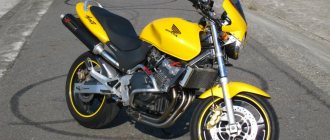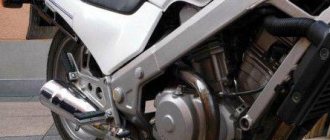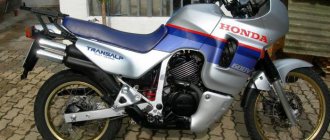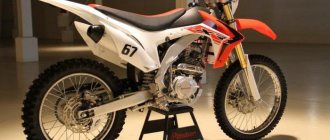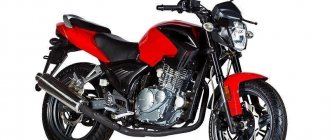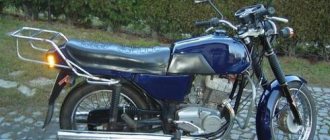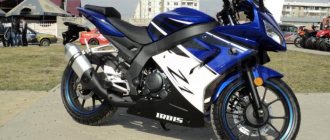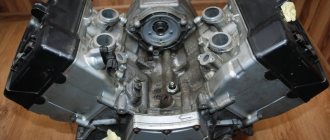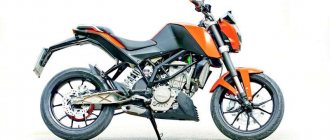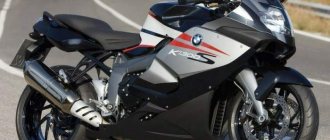Who would have thought that a motorcycle with a 1.3-liter engine could be classified as small-capacity? Nevertheless, in a family consisting of two choppers, the Honda VTX 1300 is considered the junior model. Compared to the 1.8-liter prototype, it is lighter, cheaper, and, of course, quieter on the road. At one time, the VTX 1800 surprised motorists. It was a perfectly balanced motorcycle with an excellent engine, which in its temperament went beyond the class. Therefore, when the 1.3-liter version appeared, many were skeptical and called it “stripped down.” Let's find out what is remarkable about this motorcycle and why it cannot escape the shadow of the older model.
Appearance
The motorcycles are very similar in appearance. If we go into detail, we can note the difference in the configuration of the wings and the fact that the appearance was influenced by American motorcycle trends of the 50s. The older model has more dragster-like shapes, while the younger model has classic chopper shapes. But overall the difference is insignificant. And it may not be noticeable at all to inexperienced motorcyclists. Probably, precisely so that the cars could be distinguished from each other, the designers relieved the Honda VTX 1300 of the huge muffler that distinguished the 1.8-liter version.
For whom
Here are the main features of the Honda VTX 1300:
- one carburetor, which is not typical for current cruisers from Japan;
- very large tank;
- high speed for its class.
The motorcycle is optimal for experienced cruiser drivers. It has good dynamic characteristics. The powerful exterior immediately speaks of its class, and on the road it handles like a ship - easily and smoothly.
Devices
Here, too, everything reminds us of the origin of the model. The panel located on the gas tank complies with all the canons. The backlight works well. And in the dark all instruments are perfectly readable. The lack of a tachometer is obviously due to styling features. However, he has never bothered anyone yet.
But the main miscalculation is the lack of a fuel level indicator. Although the model is intended for long trips on country roads. The good news is that the carburetor power system allows you to manually switch to reserve. A large light indicates that the engine is overheating. True, to bring a motorcycle to this state you need to try hard. The impressive fins of the cooling system radiator do their job perfectly.
Looking at the speedometer to find out your speed is quite difficult. To do this you need to show true flexibility, dexterity and courage. The main thing is not to forget to keep an eye on the road at this moment.
Honda VTX1300 motorcycle road testHonda scaled down its vision of the VTX1800 concept to create two new mid-range cruisers - and gave buyers a bona fide commercial hit.
(Based on materials from Motorcycle Cruiser magazine, December 2003. Translation and adaptation of material - A. Revutsky)
2003 was an exemplary year for Honda. 2003 saw the release of the shocking Rune and the new CBR600RR - both leaders in their classes, ushering in a new era of motorcycle technology. Amid all the hype, Honda has also decided to bring to market the smaller, low-profile VTX 1300C and its sibling, the VTX 1300S.
A year after the big-displacement headliners, you might have thought Honda's marketers would have been retarded to bring a duo of smaller-displacement cruisers to market, but the Japanese company has come out with its homework nonetheless.
After in-depth market research conducted in conjunction with dealers and customers, it became clear that there was a need for a mid-level cruiser in the market. Honda did what no one else had done before - by reducing the volume and size of the top version of the motorcycle.
| The VTX1300C has short fenders and a more dynamic look than the S model. |
With the introduction of the VTX 1800 two years earlier, the largest production V-twin cruiser, Honda had a hit on its hands. With the muscular 1800 a brand powerhouse, Honda felt it could expand its cruiser lineup and build a "VTX family" that offered the style and features of the 1800 at a lighter level. Honda downsized its monstrously powerful V-twin and the VTX 1300 was born.
The first reveal of the VTX 1300S in 2002 left no doubt that Honda was serious about building the VTX family. It became clear that this was a matter of time, that there was another model, and the formation of the clan would take place very soon.
We had the opportunity to test the retro 1300S in its first edition, but decided to wait until its drag-style twin brother, the 1300C, came together for us to fully test both bikes.
Lesser Maximum
| The S is built on the same platform, with the same engine, but has a "Retro" styling. |
Look closely at the bike and you'll see that the smaller version of the Honda VTX1800 isn't all that small. The wheelbase is 166.88 cm for the S model, and slightly less for the C.
The VTX1300 is powered by a 52-degree liquid-cooled V-twin engine with a displacement of 1,312 cc. It's certainly shorter, lighter and more maneuverable than its big, burly 1800 counterpart. However, not by much.
The main features of the Big Brother VTX and its muscular lines have been retained. The large engine with two powerful cylinders and the huge clutch cover are also eye-catching.
The 1300 engine is not a simple smaller copy of the 1800 (or a copy with minor modifications). This engine is a new interpretation of the VTX formula. It is completely developed from scratch, and differs significantly from the 1800. Although both engines have 3 valves per cylinder and water cooling, they differ not only in volume. The new 1300 V-twin is based on the 1800, but has different design details.
| Honda made the S model's exhaust pipe longer |
Each cylinder head consists of three valves - two 31 mm intake valves and one large 40 mm exhaust valve. and two spark plugs per cylinder for more efficient combustion of the mixture. Adjusting the valves is simple and consists of a bolt and lock nut. The 1300 engine has a single crankshaft journal rather than two like the 1800. Potential vibration is combatted by two dual-axis balance shafts.
The engine is mounted on carefully tailored mounts to eliminate unnecessary harmful vibration, but retain the characteristic big V-twin pulsation that adds to the pleasant driving experience.
The "small" VTX has a throttle body located under the fuel tap on the left side of the bike. In contrast to the fuel-injected VTX1800, the 1300 features a 38mm constant velocity (CV) carburetor with EPU electronic control unit that provides 3D injection for each cylinder. The difference is significant, the 1300 requires more warm-up using the throttle, especially in cold weather.
| The shorter exhaust pipe enhances the VTX1300C's sporty styling. |
Like the big boys, the smaller VTX has a 5-speed transmission that sends power to the driveshaft. Developed for the 1300, a new reverse gear mechanism is designed to reduce noise and wear on the mechanism, as well as simplify rear wheel installation. The front fork with 41 mm stays has a stroke of 130 mm. On R and S models, the fork has chrome plated guards.
The rear shocks have 94 mm of travel (9.14 mm on the C model), and 5-position spring preload adjustment.
The braking system consists of a large 336 mm front brake disc with a floating double-piston caliper and a rear 296 mm disc equipped with a single-piston caliper. The VTX1300 tubular steel frame is 4.5 cm shorter than the 1800.
| Haven't we met before? |
Indeed, the VTX 1300 and 1800 models are strikingly similar in appearance. The 1300S/R clearly takes its styling cues from the 1800R and S - it has the same tank-mounted instrument panel, large footrests and shift lever
| Models C and S have quite a lot of aesthetic differences |
rocker type gears. Deep, large fenders, an elongated chrome headlight and a diamond-shaped brake light force you to look for the nameplate on the tank to determine the engine size of the bike in front of you. But there are still differences. The side panels on the 1800s are painted in the color of the motorcycle, while on the 1300s they are covered in chrome. The 1300S has chrome spoked wheels.
The wheels of the S and R models are wearing 140/80-17 tires at the front and 170/80-15 at the rear.
| You can always identify the VTX1300S by its unique chrome side trim |
The 1300C is more of a modification than an imitation of its "big brother" 1800C.
The VTX 1300C combines the muscular hot rod styling of the original VTX with the new generation of VTX engines. Mounted on a 19-inch narrow tubeless alloy wheel up front, it has a lighter, more aggressive look thanks to short fenders, a sport seat and standard running boards. A huge chrome headlight rises above the bike, giving it sweeping and beautiful lines. The 2-into-2 exhaust is one way to differentiate it from the 1800C, which has a huge monster 2-into-1 exhaust system. The 1300C has 110/90-19 front and 170/80-15 rear wheels.
The fuel tank capacity of the 1300s is 18 liters with a reserve of 3.8 liters. With a dry weight of up to 300kg, the 1300s are 40kg lighter than the 1800s, which naturally translates into easier handling. The lower seat height – 686 mm – has a positive effect, which allows even short drivers to feel confident behind the wheel.
| Test ride |
It's when the bike moves that it really shows its personality. Although the 1300 is made from the same cloth as the 1800, this suit is worn differently. On the big 1800, you feel instantaneous, crazy power when you unscrew the throttle; the acceleration of the 1300 is much calmer and less pretentious. Although in fairness, it is worth saying that the average VTX is much faster than the cruisers of its class available on the market (with the exception of the V-ROD). Honda lists 75 hp. at 5000 rpm, and a flat torque curve. But when tested on our stand, the power at the wheel was just over 65 hp.
Adding traction also does not give that sharp push that is inherent in the 1800, and does not particularly stand out in terms of dynamics, but it has a smooth characteristic over a wide rev range. You can accelerate smoothly and energetically using the soft long gears, but some power is taken away by the transmission - more than on comparable bikes. The “tight” transmission tries to tilt the bike when you sharply open the throttle, but it lifts the rear much less. The gearshift and final drive are quite noisy, but operate very smoothly on all 1300s.
| The S gets its "retro" styling in large part from its classically styled, deep, eye-catching fenders, pipes and spoked wheels. |
The dashboard is the same on all 1300s and doesn't force you to take your eyes off the road for long. The instruments are large and not overloaded, completely housed in a chrome fairing located on the gas tank. The speedometer is overly optimistic and may show a higher speed than the actual speed (up to 10%). The panel is ascetic and made within the style. There are no such “frills” as a clock, fuel gauge or tachometer.
The C turned out to be slightly better handling than the S, perhaps due to its lighter weight, and it corners more easily, but its pegs don't allow for much lean angles. When leaning over, both models start to touch the pavement with their pegs even faster than the infamous, low Road Star, although
| With a short rear fender, rectangular taillight and almost no passenger seat, the VTX1300C looks smaller than the S. |
The footrests are hinged and foldable.
The 1300C is reluctant to come out of lean, which doesn't add to your confidence in corners. S is a little more stable in corners and when maneuvering. The soft suspension on the 1300S handles better than on the C version, and, surprisingly, it is quite nimble, more precise and predictable in corners.
All 1300 versions are lower and more comfortable to ride than the unstable 1800, but have significantly higher levels of vibration transmitted through the footpegs, handlebars and seat. Single disc brakes, although huge in size at 336mm, work adequately, but at the same time have insufficient feedback. To slow down confidently, you have to use both brakes, front and rear. In addition, the 1300 lacks the famous combined brake system of the 1800.
The C rear suspension is stiffer and absorbs shock more sharply than the S model. We tried the spring preload setting on both bikes, but neither setting was better than the recommended setting (position "2"), which is too stiff on the C model, and only slightly softer on the S. To adjust the spring presets, we used a standard tool kit hidden in a container under the left side pad.
The handlebars on the S are more comfortable and closer - its low, curved-back posts and slight bend back create a lever effect and make it easy to control the motorcycle while traveling. However, our tallest driver found the steering wheel uncomfortable. The steering wheel of the C model is made in a drag style and is not easy to reach. Having high racks and a flat profile, it is quite uncomfortable and tiring to ride for short riders. This type of steering wheel requires long arms.
The situation is the opposite with seats. In model C, the short and cup-shaped seat presses unpleasantly under the knees, especially
| The R/S and C versions have different steering wheels. |
this is felt by taller drivers who require a flatter, more open design. The S model's seat is wider, but its shape is a little shorter and can put pressure on your big butt. Naturally, when driving with a passenger, the S-model seat is preferable, the advantage of which is good visibility from the passenger seat.
We agree that the overall design of all 1300s is attractive, but there is a lot left unfinished, especially on the C version. The connection between the seat and tank on the S, for example, looks cleaner and tighter than the ugly gap on the C that reveals the tank mount . It's very disappointing to see the piles of disgusting cables and wires coming from the handlebars of both motorcycles - it's a bit un-Honda-esque, especially for a machine in this class. The good news is that the miniature VTX is assembled in the same Marysville, Ohio plant where their big brothers are built. This suggests that at least 30 additional accessories will be available for them, two-thirds of which are suitable from 1800.
| We did it |
| C has more convenient mirrors. The sight of the bundle of wires coming from the steering column is a little disappointing. |
If consumer commitment is any indication, the new VTX family of motorcycles has earned absolute popularity among the V-twin segment. The VTX 1300 achieved its goal. With less weight and a shorter wheelbase, the 1300s look significantly sleeker and are generally much more civilized and stylish than the 1800 models. But there's too much plastic on the bikes and we were left disappointed with the final finish of the 1300s. And although the price is quite reasonable, nevertheless, for example, the Kawasaki 1500 Vulcan has a slightly higher price, but is designed in more detail.
We tested the bikes mostly in urban environments, with a brief highway ride on the way back. Minimum fuel consumption was 33 mpg (7.13 L/100 km), which is the average for all test participants. We had to switch to reserve around the 110-mile mark and weren't particularly impressed with the fuel economy. For both models, we averaged less than 160 miles (256 km) of driving distance per tank, combined.
All testers agreed that the engine sound coming from the dual exhaust pipes (longer on the 1300S model) is attractively strong and textured, and preferable to the overly clean, robotic sound of the big Honda.
The 1300 will feel more comfortable than the 1100 class bikes, which are good for larger riders too. All test participants, even our “light” colleague from the sport biker breed, noted the ease of driving the VTX 1300 during our two-hour voyage around the city. He said: “Once I got used to having my legs in front of me, I was able to fully feel the handling of the bike. It's good - sometimes you need to change the pace."
While it's not perfect, VTX does a great job of serving its target audience. With the Shadow Spirit 1100 and Saber remaining in the 2004 cruiser lineup, Honda is showing that the 1300 is no replacement. For buyers, it is a good transition from the 1100 to a heavier cruiser (though not the most cost-effective). Both the Shadow 750 ACE and Shadow Spirit 750 will further represent the middleweight category in Honda's cruiser line-up. So we don't have to worry about the company's strategy - obviously Honda knows why it did it.
| Technical characteristics of the Honda VTX1300 motorcycle |
Base Price Suggested (USA): $9,199 Standard Colors: Rich Blue, Silver, Rich Orange, Black Optional : Metallic Cherry ($9,299) Standard Warranty: 12 Months, Unlimited. mileage 12 months, unlimited mileage Recommended service interval: 8000 miles
Engine
Type 4-stroke, 6-valve, liquid-cooled SOHC 52° V-twin Displacement, cm3 1312 Bore and stroke, mm 89.5 x 104.3 Compression ratio 9.2 : 1 Maximum power, kW 55 at 5000 rpm (95/1/EC) Maximum torque, Nm 123 at 3000 rpm (95/1/EC) Idle speed, rpm 900 Oil fill volume, l. 4.3
Fuel system
Power system: CV-type carburetor Throttle valve diameter, mm: 38 Air cleaner: cartridge type with paper filter Gas tank volume, l: 18 (including 3.7-liter reserve, equipped with a warning lamp)
Electrical system
Ignition: Computer-controlled digital transistor ignition system with electronic ignition timing control; 2 spark plugs per cylinder Variation of ignition timing : 4°1′ (idle) ~ 27° (at 3000 rpm) Type of spark plugs used: DCPR6E, DCPR7E (NGK), XU22EPR-U, XU22EPR-U (ND) Starter : electric Battery: 12 V/14 Ah Alternator power, W: 364 Front lighting: 12 V 55 W x 1 (low) / 60 W x 1 (far)
Transmission
Type: 5-speed Clutch: multi-plate, oil Clutch drive: cable Initial gear ratio: 1.935 (47/47 x 60/31) Gears 1 - 1.900 (38/20) 2 - 1.148 (31/27) 3 - 0.912 (31 /34) 4 - 0.778 (28/36) 5 - 0.697 (23/33) Final drive ratio: 2.6616 (17/18 x 31/11) Final drive: driveshaft
Frame
Type: Double-spar steel tube
Chassis
Dimensions, mm : 2575 x 960 x 1125 Wheelbase, mm: 1669 Pitch angle of telescopic fork: 32° Tire contact patch width, mm: 144 Turning radius, m: 3.2 Seat height, mm: 686 Ground clearance, mm : 130 Dry weight, kg: 300 Curb weight, kg: 320 (front 146, rear 174) Maximum load capacity, kg: 150 Full load weight, kg: 470 (front 178, rear 292)
Suspension
Front 41mm telescopic forks, 130mm travel Rear dual shock, 5-way spring preload adjustable, 94mm travel
Wheels
Front steel rim, wire spokes Rear steel rim, wire spokes Rim size: front 17M/C x MT3 rear 15M/S x MT3.50 Tire size: front 140/80 17M/S (69H) rear 170/80 15M/C ( 77H) Tire air pressure, kPa: front 225 rear 225
Brakes
Front hydraulic, dual 336 x 6 mm disc with 2-piston caliper, plated brake pads Rear hydraulic, 296 x 6 mm disc with 1-piston caliper, plated brake pads
Finish and weight
For a chopper, the finish is rather poor. Some shiny parts are made of plastic instead of metal. But on the other hand, the motorcycle weighs more than 300 kilograms. And the extra iron is clearly inappropriate for him. Such an impressive weight reminds itself when parking. Rolling a motorcycle by hand on level ground is a bit difficult. And if, after rash parking, you need to drive out backwards and downhill, then it’s probably better to wait until the neighboring vehicles move away and you can drive out without rolling. In general, the bike is a bit heavy. And in the case of illiterate parking, it can cause serious problems.
Main modifications of the Honda VTX 1300:
Honda VTX 1300 S - appeared first and was available until 2007. It features classic shapes (deep fenders, spoked wheels measuring 17′ and 15′, foot platforms).
Honda VTX 1300 C - has been available since 2004. It features shortened fenders, simple running boards and cast wheels in 19′ and 15′ sizes.
Honda VTX 1300 R - has been available since 2005. Similar to the S version, but with alloy wheels.
Honda VTX 1300 T - touring version. Available since 2008. Similar R-version + side cases, windshield and passenger backrest.
2009 was the last year of production of the Honda VTX1300 model, after which it was replaced by an updated series - the Honda VT1300C.
On road
The maneuverability of the Honda VTX 1300 at low speed is not at all pleasing, again due to its weight. Driving it around in traffic jams is not the most pleasant experience. And given the fact that it has an immodest width, driving through a crowded city takes almost as long as driving a car. A serious problem in this regard is the “horned” steering wheel. You have to try not to knock off the rear view mirrors.
However, organizing high-speed races in city traffic is not a royal matter. In the city, the device offers an imposing, measured ride. At the same time, as befits a real chopper, it holds a straight line perfectly on the highway. He rushes forward very confidently. And it seems that no one will knock him off course. And its solid appearance allows it to be respected on the road. On this motorcycle you don’t have to “ask” to be let through. Car drivers themselves move to the side.
Honda VTX 1300
Brief review of Honda VTX 1300
The heavy cruiser Honda VTX 1300 is one of two representatives of the VTX line. It is built on the same base as the 1800 cc model, but these motorcycles have a number of significant differences. Firstly, their engines differ not only in the working volume of the block - in fact, these are two completely different power units, and their similarities are only external. Secondly, the VTX 1300 is simpler and more budget-friendly in a technical sense (brake system, front fork, fuel supply system, clutch). The motorcycle exists in several versions, differing from each other mainly in body kit.
- VTX 1300 C - short fenders, alloy wheels
- VTX 1300 R - long fenders, alloy wheels
- VTX 1300 S - long fenders, spoked wheels
- VTX 1300 T - is an R version of the motorcycle, but has a pre-installed additional factory body kit (windshield, leather saddlebags, passenger backrest)
The Honda VTX 1300 in all its guises is a full-fledged classic cruiser - a powerful low-speed engine with impressive torque, heavy weight, an abundance of chrome (blackened versions were not produced), a comfortable fit and a cardan wheel drive.
Similar motorcycles:
- Yamaha XVS 1300 Midnight Star
- Yamaha XV1600 Road Star
- Suzuki VL 1500LC
- Kawasaki VN 1500 Vulcan
Technical characteristics of Honda VTX 1300
- Years of production: 2001-2009
- Class: cruiser
- Frame: steel
- Engine: 4-stroke, 2-cylinder, V-shaped
- Engine capacity, cubic meters see: 1312
- Cooling: liquid
- Valves per cylinder: 3
- Fuel supply: carburetor
- Power: 75 hp (at 5000 rpm)
- Torque: 123 Nm (at 3000 rpm)
- Maximum speed, km/h: 200
- Acceleration from 0 to 100 km/h: ~5.5 seconds
- Transmission: 5-speed
- Wheel drive: cardan
- Front tire: 140/80-17
- Rear tire: 170/80-15
- Front brakes: 1 disc 336 mm, 2-piston caliper
- Rear brakes: 1 disc 296 mm, 1-piston caliper
- Front suspension: telescopic fork
- Rear Suspension: Dual shock absorbers with preload adjustment
- Gas tank volume, liters: 18
- Fuel consumption at 110 km/h, liters: ~7
- Dry weight, kg: ~290 (slight differences are possible depending on the version)
Pros and benefits of Honda VTX 1300
- Huge torque available even at low revs
- High power and good acceleration dynamics
- Comfortable fit
- Reliability and maintainability
- Excellent directional stability
Pros and cons of the Honda VTX 1300
- Weak brakes
- High fuel consumption
- Heavy weight
- Weak front fork (the problem can be eliminated by replacing the springs with stiffer ones, or replacing the fork oil with a stiffer one)
- Mediocre maneuverability
Technical characteristics of Honda VTX 1300
This is where the main difference between the Honda VTX 1300 and its older brother lies. Having borrowed all the external distinctive features of the family, the bike lost the main thing. By removing 500 cubic centimeters from the engine, the designers turned a device with a bright, original character into a motorcycle devoid of individuality, of which there were, are and will be a great many.
It seems that 75 horsepower is quite enough for a chopper. But if you remember the “older” VTX, which left black marks on the asphalt after a sharp start, accelerated to 100 km/h in 3.8 seconds and literally “flyed out” of your hands, then everything falls into place. When starting at a traffic light, you can see in the mirrors not dots, but large cars. And some of them even manage to ride level with the bike. When overtaking, the confidence that was with the older model disappeared.
The 30 Nm shortfall is also very noticeable. Basically, there is enough traction, but when there is a passenger sitting in the back or the road turns into a long climb, the dynamics are not as good as we would like. It is difficult to start in second gear: the engine twitches. And as a result it stalls. There is also no elastic transmission that could be used all the way, so you constantly have to work with the gearbox.
Dimensions and weight
This is a long car – as much as 2575 mm. The width and height are 960 and 1125 mm, respectively. The seat height here is 685 mm, and the wheelbase of the motorcycle is 1670 mm. Excluding fuel, the VTX 1300 weighs 305 kg. The volume of its tank is as much as 18 liters. This is quite enough considering the average consumption per 100 km of road is 5.88 liters.
Brakes
For some reason, having removed 20 horsepower, the designers decided to eliminate the brakes. The combined system was replaced with a separate one. And one disk was removed from the front. All this had a negative impact on the braking distance. With such characteristics it is difficult to stop abruptly when necessary. You need to literally hit the rear brake pedal and squeeze the front brake lever with all your fingers. By the way, that same pedal is located outside the comfort zone of the foot. So you need to start stopping a heavy motorcycle prematurely. Of course, you can get used to all this.
Comparison with Honda Shadow (VT 1100)
Honda VT 1100 Shadow - produced since 1985. In 2007, it completely gave way to the VTX 1300 model.
Since the VT 1100 was the prototype of the VTX 1300, many tried to compare these models when choosing. Although the differences are immediately apparent.
- Carburetor . 1 block serves 2 cylinders. Shadow has 2 carbs - 2 cylinders.
- The valves are both 3-valve circuits, but previously there were hydraulic compensators for automatically adjusting the gaps; in the 1300 they are no longer there.
- Brakes . The Shadow has 2 discs in the front and a drum in the back. The new motorcycle has discs both here and there, albeit one at a time.
- Gearbox - the prototype had 4 stages .
- Clutch - 1300 received a cable for control, both earlier and later, hydraulics.
- Pendant . The working stroke of the fork on the new version has decreased from 150 mm to 110 mm, the monoshock absorber - from 100 mm to 91 mm.
In general, the bikes really turned out to be almost identical, but the hydraulic compensators added several points to the old version in comparison, while the new version added disc brakes and a 5-speed gearbox. And it’s also worth remembering the years of manufacture - the VTX 1300 is still more modern.
Control Features
Compliance with the canons of style has a negative impact on management. However, compared to other choppers, the device is quite good to drive. In a turn, when a heavy motorcycle leans, it goes as if on rails, which brings great pleasure to the biker. Driving along winding country roads would be pure ecstasy, if not for one caveat - even on a modest turn there is a risk of getting caught on the running board. And on high lying policemen, the bike even clings to the bottom. Choppers' element is long straight distances. Therefore, in principle, the fact that it clings to corners can be forgiven by Japanese designers. Well, the low bottom is apparently due to design features.
Suspension
Thanks to the massive tubular steel frame, the motorcycle has a long, classic stance. The large front fork has a travel of 130 mm and good response. The rear chrome shock absorbers received a travel of 41 mm. They include an internal valve system that enhances ride comfort. However, the landing remains a bit harsh.
The suspension allows you to overcome small potholes without slowing down. The main thing is not to get carried away and make sure that large ones do not appear after the small ones. After all, then the soft front fork can easily break down. But the rear suspension is much more difficult to get to work for the entire stroke. In general, not a bad detail, as for a chopper.
Chassis and brakes
The tubular frame is made of durable steel. The motorcycle looks great; its exterior has all the classic cruiser features. The alloy wheels look stylish, and the steering wheel has a traditional look.
The pendulum rear suspension is combined with two shock absorbers. At the front, it's a simple 41mm telescopic fork. The rear brakes are equipped with a single-piston caliper and a 296 mm diameter disc, while the front brakes are equipped with a 336 mm diameter disc and a two-piston caliper.
Honda VTX 1300: reviews
As expected, the bike received mixed reviews from owners. Let's start with the design. A stylish and elegant bike can attract attention. This is due to the deep fenders, wide steering wheel and massive clutch cover. By and large, tuning the Honda VTX 1300 is not necessary at all. It can only harm the classic image of a motorcycle.
Now a little about landing. So, it is quite low, which allows, firstly, short people to get behind the wheel, and secondly, to confidently control the bike with their feet. But the “broad shoulders” of a motorcycle can become a real problem for those who want to outwit city traffic. The seats are large, but not particularly comfortable. Therefore, after long trips, many people complain of fatigue. The mirrors are also not very well made and sometimes there is clearly not enough visibility.
It's time to discuss opinions on the powertrain. The engine, according to reviews from owners, fully lives up to expectations. For its size, it accelerates the bike well and holds speed steadily. The gearbox operates quite clearly, without jerking. Of course, when compared with the older model, this motorcycle has a rather weak character. But whoever buys it must initially understand this. After all, the device is designed for less dynamic and more economical driving.
Due to the long wheelbase and rather rigid frame, the bike’s riding style is very specific, but this is a matter of habit. And large wheels help the suspension deal with small irregularities. The motorcycle clearly gets the highest marks for the level of illumination - the headlights focus the beam clearly and shine well. Although the brakes are inferior to their older brother, they cope with their task quite well compared to other “classmates”.
Among the obvious miscalculations of the Japanese company, owners note the dashboard located on the gas tank with its uncomfortable small speedometer. Well, the fact that there is no low fuel level sensor in the tank causes indignation. Users assure that the motorcycle has one disease that is easier to accept than to fight - the steering wheel shakes at a speed of 40-50 km/h. But since the speed is not very “running”, they usually turn a blind eye to this.
For those who decide to go on a long journey, it would be useful to purchase some accessories for the Honda VTX 1300. We are talking about the windshield and the arches behind the back. You need to be prepared for the fact that such useful modifications can negatively affect the elegance of the bike. As reviews show, the motorcycle is quite reliable in operation. With breakdowns, anything can happen. As a rule, nothing critical. In any case, you can purchase spare parts. Honda offers a fairly high-quality product, so the bike can be trusted. It is recommended to prepare your car for the season ahead of time, so as not to spend precious warm days in the garage. By changing consumable spare parts (Honda), checking all the fluids, you can be sure that the season will pass without unpleasant surprises.
Review of the Honda VTX 1300 motorcycle
This is my first VTX 1300 motorcycle. I’m overweight, almost 130. I’ve been driving cars for 11 years, and I don’t seem to have any headaches.
I took 1300 and not 1800 only because the youngest version was a very good option for very little money. Well, it seems that 1800 will be the first motor, this is completely overkill, I’ll start with 1300, and then we’ll see. The 1800 still has at least 2 undeniable advantages (for me) - the injector and the braking system. Well, power is an additional bonus, although 1300 is enough for now.
As for the weight... I also doubted it at first, someone scared me that I couldn’t lift it alone... complete bullshit. Even at the place of purchase, I carefully laid the moto on its side and picked it up without any problems.
I really praised myself for installing the arches. Already when it got cold, on some muddy terrain made by dump trucks, I blocked the front wheel. He flopped onto his right side. The mot lay on the arc and only a small abrasion remained on it. You can lift the motorcycle from the arc with almost one hand.
By the way, even before I installed the roll bars, in the first days I started skidding on the sand at low speed while turning. I caught the motorcycle and didn't put it away. In general, the weight of the motorcycle doesn’t bother me, but I’m not light myself.
And during the part of the season that I managed to capture, I even rode through the mud. You can already feel the heaviness here, but you just need to be careful and not go into prolonged drifts =)
In general, if you have already gotten rid of unreasonable boyishness and have more than 85 kg of meat in your body, then I think Vtyks may well be the first motorcycle.
I personally switched to VTX from Steed 400 hundred. True, before that I had almost 20 years of experience driving two-wheelers of various modifications and weight categories. So, my personal acquaintance with the VTX 1300R was a couple of hours of rolling on the site, about the same in the city, on the highway , and I’m already on familiar terms with this “monster”, and after three days of riding it and a mileage of 450 km, I realized that this bike was created for a person, such pleasure from riding, and a sea of positive emotions, I have never had one of my “horses” didn't give it.
For me personally, there are no problems with taxiing and parking in a sticky position at all. The 1300 steers excellently, I don’t know thanks to what performance characteristics this was achieved, but for a cruiser in first gear at the minimum possible speed, you can freely balance without touching the ground with your feet, while not feeling it as stated 300 kg of weight. There is simply no need to hold the bike while standing, it stands under you, and I agree with the opinion of people that when you pick up speed, the stick just rushes to the spot. Of course, all of the above is true for a rider who has experience driving motorcycles, and not people who have just received their license, and try to ride this “monster”.
The acceleration dynamics are enough for me personally, 5 seconds to 100 is not enough for a cruiser?
It’s still better to start your practice with something easier, at least in order to gain certain skills in driving a motorcycle, and dropping a stick on the asphalt is still not ice, for these purposes you can buy an Izha for a nickel and practice on it, and It wouldn’t be a shame to kill him, the main thing is to stay safe.
For those who have experience driving motorcycles, in my opinion it won’t be difficult to ride a pole, it’s all in your head, and not the weight of the pole. Well, I also want to say a few words about comparisons between the 1300 and 1800 - guys, there is no need to equate them except for their appearance and some minimally similar components, the only thing these motorcycles have in common is the manufacturer, and to say that the 1800 is better than the 1300 is the same as to say that that, for example, the VAZ 2110 is better than the VAZ 2101, this is clear to everyone.
I have a VTX - my second motorcycle, before it I had a Honda Shadow 750. At the beginning of last season I bought a VTX 1300, 2004, for 270 rubles. I looked at 1800, there was an option to take a motorcycle from the early 2000s, but I decided that I didn’t need almost two liters. I don’t regret the decision. SWORD 1300 is already faster than all its classmates in its cubic capacity, you can’t argue with that. It can easily travel 250 km on a tank, although if you burn it with all your money, you can burn out the tank in 150 km. At 110 km/h it consumes about 6 and a half liters of 92 benzene. Among the problems during the entire period of operation were a soured brake cylinder and a carburetor, which suddenly began to richly rich the mixture. I tinkered with the carburetor for a month, and in the end, after about the tenth overhaul, it suddenly started working normally. I still don’t understand what the problem was.
I looked at 1800, there was an option to take a motorcycle from the early 2000s, but I decided that I didn’t need almost two liters. I don’t regret the decision. SWORD 1300 is already faster than all its classmates in its cubic capacity, you can’t argue with that. It can easily travel 250 km on a tank, although if you burn it with all your money, you can burn out the tank in 150 km. At 110 km/h it consumes about 6 and a half liters of 92 benzene. Among the problems during the entire period of operation were a soured brake cylinder and a carburetor, which suddenly began to richly rich the mixture. I tinkered with the carburetor for a month, and in the end, after about the tenth overhaul, it suddenly started working normally. I still don’t understand what the problem was.
In general, the comrade above described everything correctly, and it is true for both the VTX 1800 and 1300. The only difference is in weight, which is small, and in torque horses. I accelerated the SWORD to 180 km/h, purely and for sporting purposes) And yes, everything is the same, a big heavy chopper that bites into the road at a speed so that mom don’t worry) IMHO, it’s practically a standard in its class.
